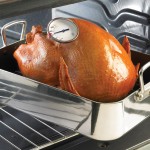by Judy Corbus | Nov 26, 2013
Normal
0
false
false
false
EN-US
X-NONE
X-NONE
/* Style Definitions */
table.MsoNormalTable
{mso-style-name:”Table Normal”;
mso-tstyle-rowband-size:0;
mso-tstyle-colband-size:0;
mso-style-noshow:yes;
mso-style-priority:99;
mso-style-parent:””;
mso-padding-alt:0in 5.4pt 0in 5.4pt;
mso-para-margin-top:0in;
mso-para-margin-right:0in;
mso-para-margin-bottom:8.0pt;
mso-para-margin-left:0in;
line-height:107%;
mso-pagination:widow-orphan;
font-size:11.0pt;
font-family:”Calibri”,”sans-serif”;
mso-ascii-font-family:Calibri;
mso-ascii-theme-font:minor-latin;
mso-hansi-font-family:Calibri;
mso-hansi-theme-font:minor-latin;}
 The highlight of many Thanksgiving meals is the turkey –juicy, golden brown, and delicious! Before and after it reaches the table, however, follow these steps to reduce your guests’ risk of foodborne illness.
The highlight of many Thanksgiving meals is the turkey –juicy, golden brown, and delicious! Before and after it reaches the table, however, follow these steps to reduce your guests’ risk of foodborne illness.
Thaw the turkey safely:
- In the refrigerator at 40oF or below– allow 24 hours for every 5 pounds. Place the turkey in a container to prevent the juices from dripping on other foods. Cook within 1-2 days.
- In cold water – submerge the turkey in a leak-proof plastic bag in cold water. Change the water every 30 minutes until the turkey is thawed; allow 30 minutes per pound. Cook turkey immediately after it is thawed.
- In the microwave oven – check your owner’s manual for specific instructions for defrosting a turkey. Plan to cook it immediately after thawing because some areas of the food may become warm and begin to cook during microwaving. Holding partially cooked food is not recommended because any bacteria present would not have been destroyed.
For roast turkey, set the oven temperature no lower than 325°F. For optimum safety, cook stuffing in a casserole. If stuffing your turkey, mix ingredients just before stuffing it; stuff loosely. Additional time is required for the turkey and stuffing to reach a safe minimum internal temperature.
APPROXIMATE COOKING TIMES
(325°F oven temperature)
UNSTUFFED (time in hours)
- 4 to 6 lb. breast — 1 1/2 to 2 1/4
- 6 to 8 lb. breast — 2 1/4 to 3 1/4
- 8 to 12 lbs. — 2 3/4 to 3
- 12 to 14 lbs. — 3 to 3 3/4
- 14 to 18 lbs. — 3 3/4 to 4 1/4
- 18 to 20 lbs. — 4 1/4 to 4 1/2
- 20 to 24 lbs. — 4 1/2 to 5
STUFFED (time in hours)
- 8 to 12 lbs. — 3 to 3 1/2
- 12 to 14 lbs. — 3 1/2 to 4
- 14 to 18 lbs. — 4 to 4 1/4
- 18 to 20 lbs. — 4 1/4 to 4 3/4
- 20 to 24 lbs. — 4 3/4 to 5 1/4
Use a food thermometer to ensure your turkey is safe. Insert thermometer in the innermost part of the thigh, wing, and the thickest part of the breast. The turkey is safe at 165°F. Let the bird stand 20 minutes before removing stuffing and carving.
After the big meal, perishable foods should not be left out of the refrigerator for more than 2 hours. Remove all stuffing from the turkey cavity immediately and refrigerate. Cut turkey into smaller pieces and refrigerate. Slice breast meat; legs and wings may be left whole. Refrigerate potatoes, gravy, and vegetables in shallow containers.
Refrigerator-stored cooked turkey and cooked dishes and gravy should be eaten within 3 to 4 days. Reheat leftovers thoroughly to 165°F or until hot and steaming; bring gravy to a rolling boil. In the microwave oven, cover food and rotate dish so it heats evenly.
For longer-term storage, freeze food in airtight freezer containers or bags and use within 4 to 6 months for best quality.
Questions on Thanksgiving Day?
Ask Karen, the virtual food safety representative, is available 24/7 at AskKaren.gov. Weekdays between 10 a.m. and 4 p.m. ET, the USDA Meat and Poultry Hotline is available at 1-888-MPHotline (1-888-674-6854). On Thanksgiving Day, the Hotline will be open from 8:00 am to 2:00 pm Eastern Time.
Happy Thanksgiving!
Source: USDA Food Safety and Inspection Service, www.fsis.usda.gov.
by Dorothy C. Lee | Jul 17, 2013
 “It must be something I ate” often is the explanation people give for a bout of home-grown “Montezuma’s Revenge” or some other unwelcome gastrointestinal upset.
“It must be something I ate” often is the explanation people give for a bout of home-grown “Montezuma’s Revenge” or some other unwelcome gastrointestinal upset.
Despite the fact that America’s food supply is the safest in the world, the unappetizing truth is that what we eat can very well be the vehicle for food-borne illnesses. It is estimated that 76 million cases of food-borne illness occur in the United States every year.
The Food and Drug Administration has given high priority to combating microbial contamination of the food supply but part of the responsibility for preventing food-borne illness lies with the consumer. It is estimated that 35 to 40% of food-borne illness in the United States results from unsafe handling of food at home.
The prime causes of foodborne illness are a collection of bacteria with tongue-twisting names. These organisms can become unwelcome guests at potlucks, picnics, and the dinner table.
They are in a wide range of foods, including meat, eggs, milk and dairy products, coconut, chocolate, seafood, and even water.
Careless food handling sets the stage for the growth of disease-causing organisms. For example, hot or cold foods left standing too long at room temperature provide an ideal environment for bacteria to grow. Improper cooking also plays a role in foodborne illness.
Foods may be cross-contaminated when cutting boards and kitchen tools that have been used to prepare a contaminated food, such as raw chicken, are not cleaned before being used for another food, such as vegetables.
Symptoms
Common symptoms of food-borne illness include diarrhea, abdominal cramping, fever, and vomiting. However, symptoms will vary according to the type of bacteria and the amount of contaminants eaten. For most healthy people, food-borne illnesses are neither long-lasting nor life-threatening. However, they can be severe in the very young, the very old, and those whose immune systems are suppressed.
Prevention Tips
The idea that the food on the dinner table can make someone sick may be disturbing, but there are many steps you can take to protect your family and dinner guests. It is just a matter of following basic rules of food safety.
Prevention of food poisoning starts with your trip to the supermarket. Pick up your canned and packaged foods first. Don’t purchase food in cans that are bulging or dented, or in jars that are cracked. Look for expiration dates on the labels. Likewise, check the “use by” or “sell by” date on dairy products such as cottage cheese, cream cheese, yogurt, and sour cream. Pick the ones that will stay fresh longest in your refrigerator.
When choosing eggs, open the carton and make sure that none are cracked or leaking.
Place frozen foods and perishables such as meat, poultry, and fish in your cart last. Always put these products in separate plastic bags so that drippings don’t contaminate other foods in your shopping cart. Bag cold and frozen foods together, and if it will take more than an hour to get your groceries home, take along an ice chest to keep frozen and perishable foods cold.
Safe Storage
Be sure to refrigerate or freeze perishables as soon as you return from the grocery store. Refrigerator temperature should be 40°F or below and the freezer should be 0°F or below.
For foods that can be stored at room temperature, some precautions will ensure they remain safe.
Store potatoes in a cool dry place—not under the sink or in the refrigerator. Don’t store foods near household cleaning products and chemicals. When you are putting canned food items away, store the older canned items to the front and canned items with the longest-out dates of use in the back row so you’ll be sure to use the older ones first.
Keep It Clean
The first rule of safe food preparation is to keep everything clean. This rule applies to the areas where food is prepared and, most importantly, to the cook. Wash hands thoroughly before starting to prepare a meal and always after handling raw meat and poultry. Keep the work area clean. Wash fruits and vegetables thoroughly. Do not put cooked meat on an unwashed platter that has held raw meat.
The second rule of safe food preparation is keep hot foods hot and cold foods cold.
After the meal, leftovers should be refrigerated as soon as possible.
Here are a few more tips to keep your favorite dishes safe:
- Don’t thaw meat and other frozen foods at room temperature.
- Thaw in the refrigerator or microwave.
- Never taste food that looks or smells spoiled.
All these dos and don’ts may seem overwhelming, but remember: if you want to stay healthy, the old saying, “rules are made to be broken,” does not apply to food safety!
For further information regarding food safety and other related topics, go to the University of Florida’s Solutions for Your Life website: http://www.solutionsforyourlife.com.
Reference: Safe Food Handling Fact Sheets, United States Department of Agriculture, Food Safety and Inspection Service
 The highlight of many Thanksgiving meals is the turkey –juicy, golden brown, and delicious! Before and after it reaches the table, however, follow these steps to reduce your guests’ risk of foodborne illness.
The highlight of many Thanksgiving meals is the turkey –juicy, golden brown, and delicious! Before and after it reaches the table, however, follow these steps to reduce your guests’ risk of foodborne illness.
